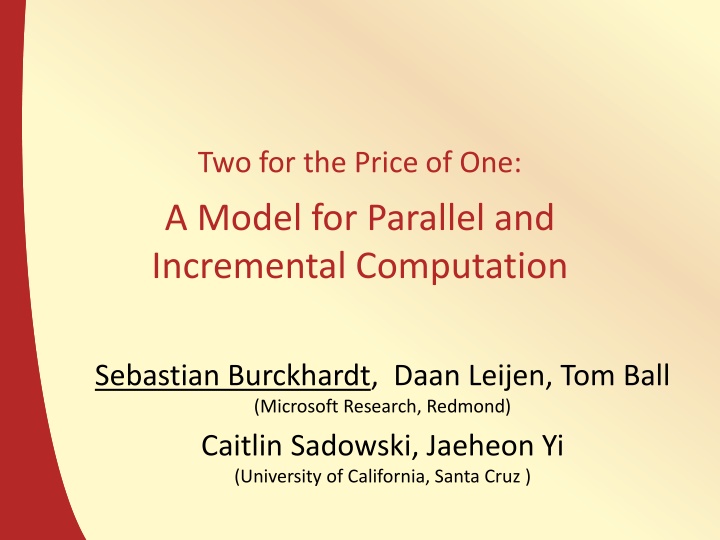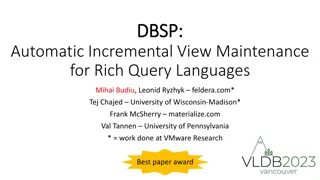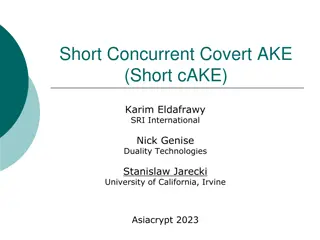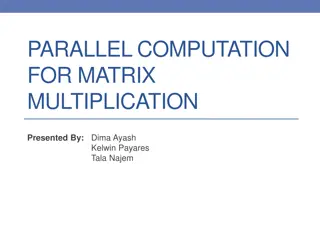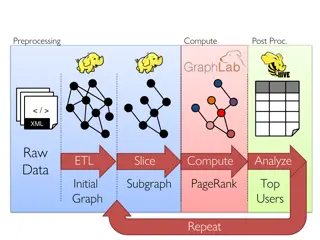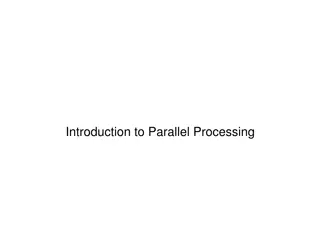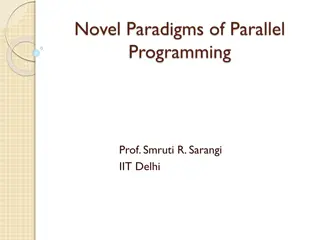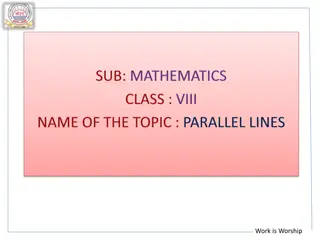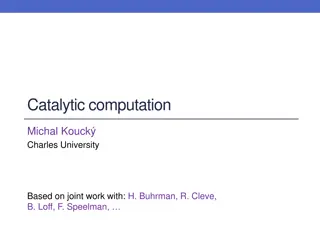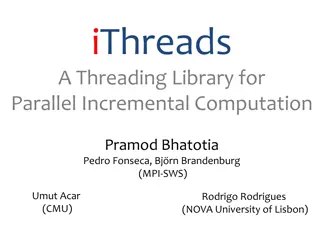A Model for Parallel and Incremental Computation
This model explores the concept of parallel and incremental computation, focusing on compute-mutate loops, self-adjusting computation, and dynamic task graphs. It introduces primitives like fork, join, record, and repeat to express computation effectively. The goal is to enhance performance in various applications by utilizing deterministic parallelism and optimized types.
Download Presentation

Please find below an Image/Link to download the presentation.
The content on the website is provided AS IS for your information and personal use only. It may not be sold, licensed, or shared on other websites without obtaining consent from the author.If you encounter any issues during the download, it is possible that the publisher has removed the file from their server.
You are allowed to download the files provided on this website for personal or commercial use, subject to the condition that they are used lawfully. All files are the property of their respective owners.
The content on the website is provided AS IS for your information and personal use only. It may not be sold, licensed, or shared on other websites without obtaining consent from the author.
E N D
Presentation Transcript
Two for the Price of One: A Model for Parallel and Incremental Computation Sebastian Burckhardt, Daan Leijen, Tom Ball (Microsoft Research, Redmond) Caitlin Sadowski, Jaeheon Yi (University of California, Santa Cruz )
Motivation: Compute-Mutate Loops Deterministic No I/O Potentially Parallel Nondeterministic I/O Common pattern in applications (e.g. browser, games, compilers, spreadsheets, editors, forms, simulations) Goal: perform better (faster, less power)
Incremental Computation Parallel Computation input input input Comp utat ion Comp utat ion Comp utat ion Computation Computation output output output Which one would you choose? Do we have to choose?
Incremental + Parallel Computation input Self-Adjusting Computation: Dynamic Dependence Graph Work Stealing: Dynamic Task Graph Comp utat ion Comp utat ion Comp utat ion Comp utat ion Comp utat ion Comp utat ion output
Two for the Price of One input ? Small set of primitives to express computation ? output Wanted: Programming Model for Parallel & Incremental Computation
Our Primitives: fork, join, record, repeat Start with Deterministic Parallel Programming Concurrent Revisions Model fork and join Revisions (= Isolated Tasks) Declare shared data and operations on it Add Primitives for record and repeat c = record { f(); } for some computation f() repeat c is equivalent to calling f() again, but faster the compute-mutate loop does record mutate repeat mutate repeat
[OOPSLA 10] [ESOP 11] [WoDet 11] Concurrent Revisions Model 0 1 1 x.Set(1) Deterministic Parallelism by fork and join (creates concurrent tasks called revisions) Revisions are isolated fork copies all state join replays updates Use optimized types (copy on write, merge functions) fork 11 1 1 1 1 1 1 1 1 1 1 111 fork 1 1 1 1 1 1 1 x.Set(2) 2 2 2 2 2 x.Add(3) 4 4 4 4 4 444 2 join 22 2 join 5 5
Example Step 1: Record
Example (Cont d) Step 2: Mutate Step 3: Repeat
How does it work? On Record Create ordered tree of summaries (summary=revision) Revisions-Library already stores effects of revisions Can keep them around to reexecute = join again Can track dependencies Record dependencies Invalidate summaries At time of fork, know if valid r r2 r1 r1.1 r1.2 r2.1 r2.2
Illustration Example Consider computation shaped like this (e.g. our CSS layout alg. with 3 passes) r1.1 r1.2 r1 r2.1 r2 r2.2 r1.1 c = record { pass1(); pass2(); pass3(); } reads x r1.2 r1 r2.1 r r2 r2.2 r1.1 r1.2 r1 r2.1 r2 r2.2
Illustration Example Consider computation shaped like this (e.g. our CSS layout alg. with 3 passes) r1.1 r1.2 r1 r2.1 r2 r2.2 r1.1 c = record { pass1(); pass2(); pass3(); } Dep. on x r1.2 r1 r2.1 r r2 r2.2 x = 100; r1.1 r1.2 r1 r2.1 r2 r2.2
Illustration Example Consider computation shaped like this (e.g. our CSS layout alg. with 3 passes) r1.1 r1.2 repeat record r1 r2.1 r2 r2.2 r1.1 c = record { pass1(); pass2(); pass3(); } r1.2 r1 r2.1 r r2 r2.2 x = 100; r1.1 r1.2 repeat c; r1 r2.1 r2 r2.2
Illustration Example Consider computation shaped like this (e.g. our CSS layout alg. with 3 passes) r1.1 r1.2 repeat record r1 r2.1 r2 r2.2 r1.1 c = record { pass1(); pass2(); pass3(); } r1.2 r1 r2.1 r r2 r2.2 x = 100; r1.1 r1.2 repeat c; r1 r2.1 r2 r2.2
Illustration Example Consider computation shaped like this (e.g. our CSS layout alg. with 3 passes) r1.1 r1.2 repeat record r1 r2.1 r2 r2.2 r1.1 c = record { pass1(); pass2(); pass3(); } r1.2 r1 r2.1 r r2 r2.2 x = 100; r1.1 r1.2 repeat c; r1 r2.1 r2 r2.2
Illustration Example Consider computation shaped like this (e.g. our CSS layout alg. with 3 passes) r1.1 r1.2 repeat record r1 r2.1 r2 r2.2 r1.1 c = record { pass1(); pass2(); pass3(); } r1.2 r1 r2.1 r r2 r2.2 x = 100; r1.1 r1.2 repeat c; r1 r2.1 r2 r2.2
Invalidating Summaries is Tricky May depend on external input Invalidate between compute and repeat May depend on write by some other summary Invalidate if write changes Invalidate if write disappears Dependencies can change Invalidate if new write appears between old write and read And all of this is concurrent
Who has to think about what Our runtime The programmer Detects nature of dependencies Dynamic tracking of reads and writes Records and replays effects of revisions Schedules revisions in parallel on multiprocessor (based on TPL, a work- stealing scheduler) Explicitly structures the computation (fork, join) Declares data that participates in Concurrent accesses Dependencies Thinks about performance Revision granularity Applies Marker Optimization
Optimizations by Programmer Granularity Control Problem: too much overhead if revisions contain not enough work Solution: Use typical techniques (e.g. recursion threshold) to keep revisions large enough Markers Problem: too much overhead if tracking individual memory locations (e.g. bytes of a picture) Solution: Use marker object to represent a group of locations (e.g. a tile in picture)
Results on 5 Benchmarks On 8 cores, recording is still faster than baseline (1.8x 6.4x) Repeat after small change is significantly faster than baseline (12x 37x) Repeat after large change is same as record
What part does parallelism play? Without parallelism, record is up to 31% slower than baseline Without parallelism, repeat after small change is still 4.9x 24x faster than baseline
Contributions Philosophical Connect incremental and parallel computation Programming Model Concurrent Revisions + record/repeat Algorithm Concurrent summary creation, invalidation, replay Empirical Implement C# Prototype Measure on Examples Identify Important Optimizations
